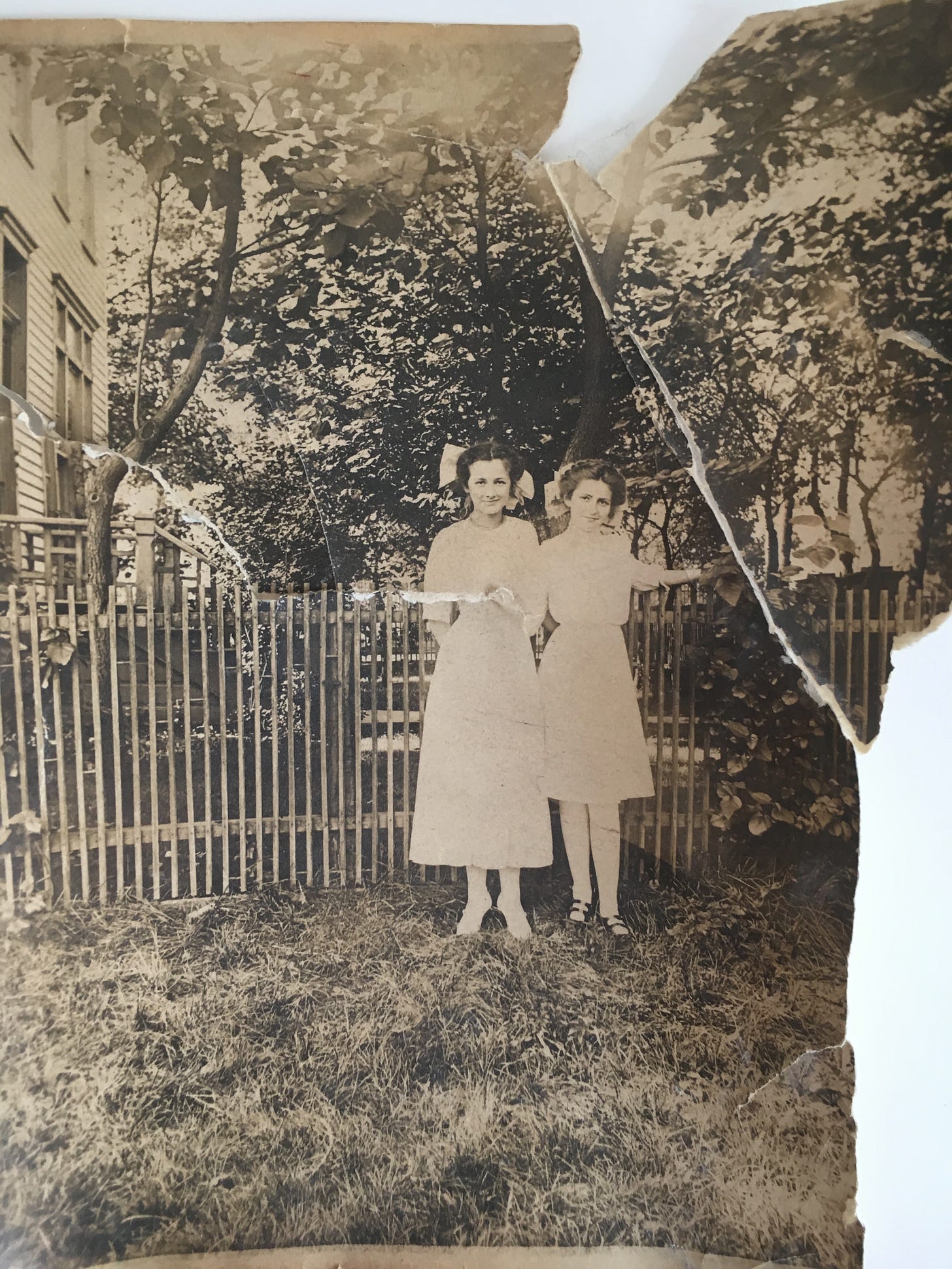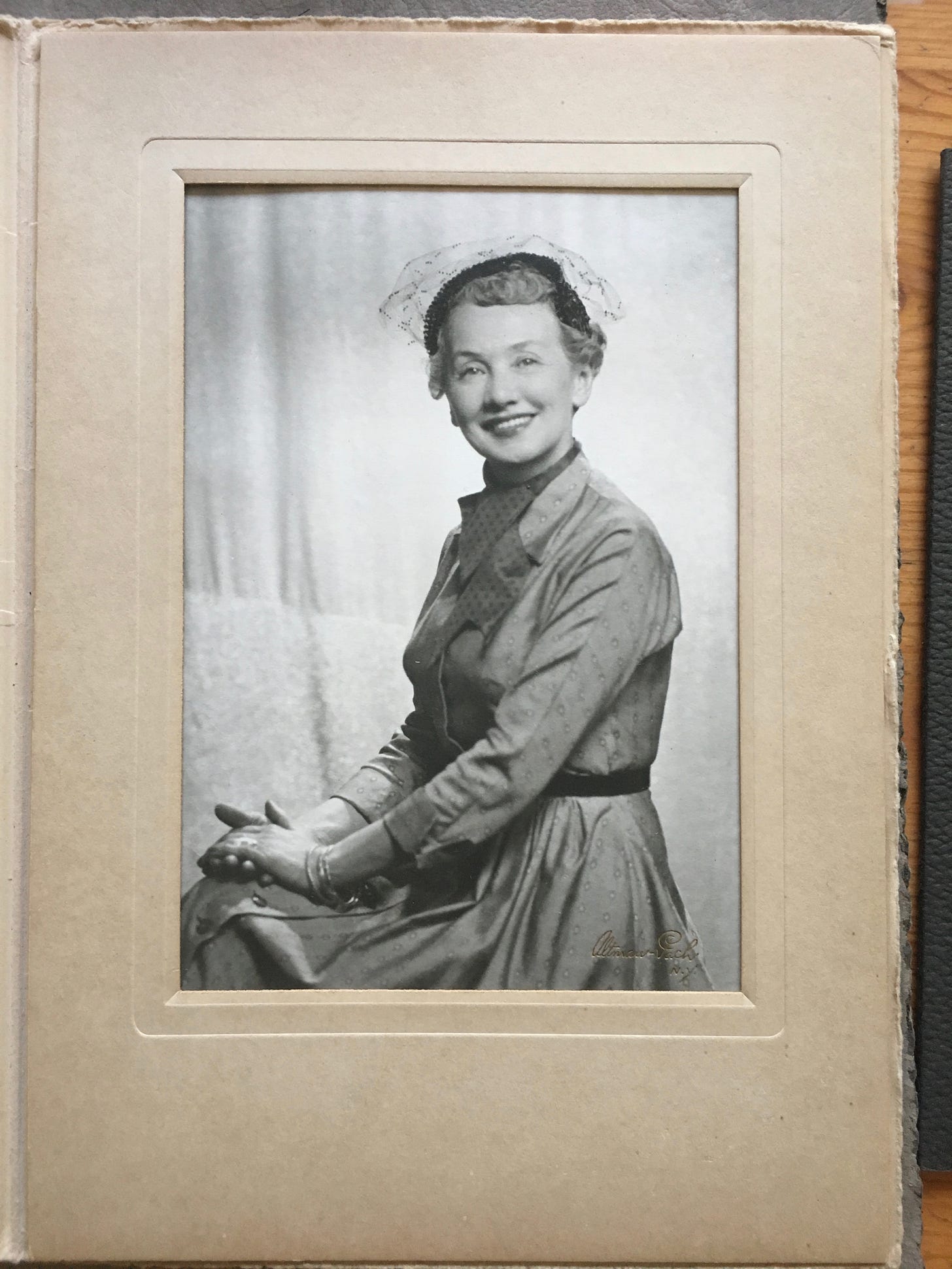The photo is torn and discolored with age. On the back my grandfather wrote in a script with flourishes:
Cast of Characters
Miss Elsie Anderson
Miss Leila Young
Mister Andrew P. Olsen, Photographer
Some of the note is torn off but it seems to read “June, Lexington Avenue, 1909. Just your Andrew now. Elsie Marguerite (Andrew’s bride to be).” This photo and a drawing Andrew made of Elsie later rests on the bookshelf behind my desk. They probably get too much sun. I found both scraps of paper crumpled up between other books and papers when I unpacked some boxes. They are precious but ordinary.
My father’s mother Elsie was much photographed and this is one of the earliest. As usual, she is clearly posing. There are few spontaneous shots of her doing anything besides smiling for a camera. Even the many photographs taken of her pushing me in a swing in Riverside Park when I was a toddler show that eye-squinting smile. She died when I was four years old and remains an enigma to me. Here is what I know:
• She was born in Chicago into a large family with a German mother and an Irish father who drank. The eldest daughter, she was named after her mother Elise, and there have been Alices in every generation of our family since. She left high school to work as a typist at Carson, Pirie, Scott, the elegant department store in the Loop.
• She liked to bake.
• According to my mother, her speech was peppered with “am I right, Andrew?” “Yes, doll,” he’d reply.
• Her husband and sons adored her.
This particular image is not a carefully crafted art photograph but it is more charming than the typical studio portrait, like the one I reproduce below. With the sun shining through the trees, the vertical lines of the fence and the horizontal lines of the shingled house frame the two girls effortlessly. The grass in the foreground, though black and white and crumpled under foot, gives the whole picture some texture. Both Elsie and Leila look demure and girlish in their white dresses and big bows in their hair. (Who was Leila? She appears nowhere else in the archive.) Elsie, the taller of the two, may have been the elder. Her dress covers more of her legs and she faces the camera directly, whereas Leila tilts her head and seems more off balance.
But with her hands hidden behind her back, Elsie too may be withholding something from us. (She worked with those hands: baking and typing.) There is a bit of uncertainty in her pose and some confusion in the inscription. If this photo was taken in 1909 Elsie was fourteen years old and Andrew was fifteen so he must have written the inscription much later: he didn’t marry Elsie until 1921. When asked, my mother confirmed that the couple had known each other from age twelve. “I think he rescued her,” my mother adds. “Her family was poor and she was the eldest of many kids.”
Andrew was born at 7105 W. Lexington Street, Chicago1 in 1894 so the photo may have been taken in front of his parent’s home. Now Google Maps shows a Motor Vehicle Facility there with a chain link fence on an empty thoroughfare. Elsie was born in 1895 at West Congress Parkway and South Ashland Avenue, about five miles due east of Andrew’s family home. That too is now an industrial intersection. It’s not clear how they met. By the 1910 census both the Olsens and the Andersons had moved to the South Side.
Andrew was a commercial designer by training and trade, and he drew Elsie several times: before their wedding he made an informal pencil sketch “TO HIS OWN BRIDE.” She looks a little droopy. He also drew a formal portrait of her in charcoal that hung in my father’s house and then in my office for many years. Later, Elsie would seem the perfect wife for a successful product designer. She was lovely, well dressed, and smiling; the portrait below, taken at the photo studio in the B. Altman department store on a visit to New York City in the 1950s, is typical. Andrew was Elsie’s interpreter, presenting her to the public. Surprisingly, my father rarely spoke of her. I have no real memories of her myself.
Instead of memories or stories I have stuff. Andrew saved tiny scraps of paper in cardboard boxes and a wide assortment of objects like binoculars, stick pins, cufflinks, a clothes brush, and a monogrammed flask. He labeled them carefully as if awaiting his biographer: a box of watches labeled WATCHES, his wife’s jewelry in a box labeled ELSIE’S JEWELRY. Among the costume jewelry and cloisonné compacts Andrew saved there is a cheap metal button that looks like any other election pin—or promotional swag. Except the face on the front is Elsie’s, cropped from a studio portrait of her as a teenager. Who made it and who once wore it? Now it feels like a strangely literal commodification, a relic marking the place where mass production meets family history.
Button-Elsie looks uncharacteristically serious. What was she thinking? To create her as a character I need her voice, but Elsie left only one document in the archive in her own voice and hand (not typed!): a card for my father on his 40th birthday. She calls him a “fine young man” and wishes him “Health, Happiness, and Contentment” with his growing family. She lives most in the photos and objects she left behind, though the enameled compacts of powder and lip rouge her husband saved may have traces of her DNA, for all I know.
Now that I’ve looked at all this evidence, Elsie seems packaged. The bow in the earliest photograph seems like an early sign of the wrapping that would enclose her personhood in roles and consumer goods. She was more artifact, or even art, than person.
This is the first excerpt in a series I think of as character sketches, where I spend some time on one “character” from my memoir about my father’s art career. In this case, I’ve started with the one I know the least about, despite the mountains of evidence left behind. I try to convey that disparity above.
My thoughts on this excerpt, now:
Where are we? Chicago, Riverside Park in New York City, my basement in Brooklyn. I like the before-and-after details about my grandparents’ homes in Chicago but do readers care about those? I cut them in later drafts. I like the paragraph that describes the photo in detail: it’s easy to rush over the evidence but worth spending one paragraph just looking at it.
When are we? The opening jumbles past and present confusingly, moving between verb tenses. That reflects the vertiginous confusion of the 1909 photograph with its later caption. I’m aiming for something difficult here—simultaneity in two time periods—but not sure I succeed.
Who are they? I have Andrew’s voice, but the lack of Elsie’s own voice is a structural problem for me, which I solved using my mother’s instead. It adds “dialogue” to the exposition, mixing in a new texture.
What does it mean? I look at what’s left of my grandmother, as well as what’s missing, and decide that she was “packaged” by my grandfather, known for his visual taste. I build a case with visual analysis (the bow in her hair) and connections to my grandfather’s career in consumer culture. I think that interpretation is strong but I probably rush it a little bit. In one draft I spend much more time on the history of department stores to provide a context for consumerism.
The memoir, of course, has more about Elsie herself but not that much more; she remains an enigma to me and I don’t engage deeply with why that might matter. She lost a beloved son, her firstborn Andrew Jr., and was deeply mourned in her turn. Grief seems a key part of the story, as always.2 Why did my grandfather and father mourn her so deeply if she now seems so hollow? How might her death, the year before my parents’ divorce, have propelled my father into leaving his own family? Why are my memories of her so vague? Those are questions I don’t ask, implicitly or explicitly, in this excerpt. I also don’t go into another source I did have for Elsie’s life: her much-younger sister Marie, whom I interviewed in the 1990s. Marie deserves her own story though, and another character sketch.
Thank you for reading this far! This is the last of my memoir excerpts for the year. I may shake up the format next year. Please let me know in the comments (or via email) if you have preferences or suggestions— and remember to like, share, and comment below, if you can. Next week, for the holiday, I will skip the usual memoir excerpt and share a special post I’ve queued up. Stay tuned!
Exercise: Describe a person in your memoir as a character, from the outside in. What artifacts have they left behind? What does that tell you about them? How did other people describe— or “package”— them for others, or for the future? Consider what this might mean for your memoir.
Was “Lexington Avenue” in Andrew’s inscription my mistake or his? I checked and that is what he wrote, though there is no Lexington Avenue in Chicago, only a Lexington Street, East or West.
See E.M. Forster’s famous distinction from Aspects of the Novel (1926, the year my father was born): “‘The king died and then the queen died’ is a story. ‘The king died, and then the queen died of grief’ is a plot.” This quote is foundational for my memoir. I’ll write more about it soon.







